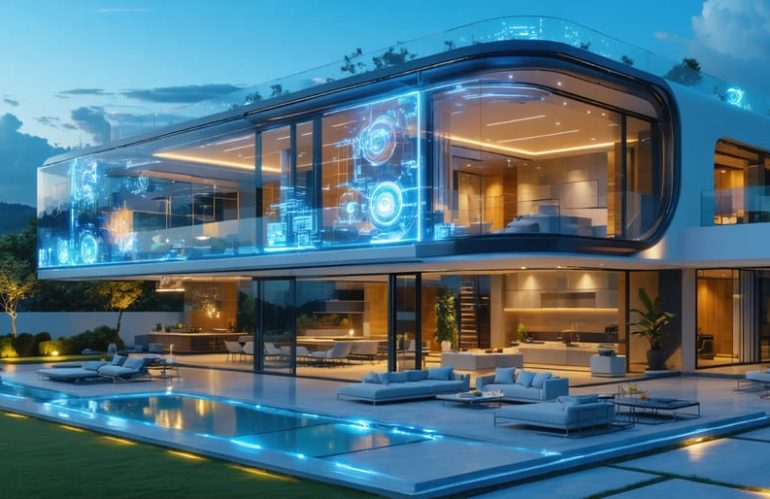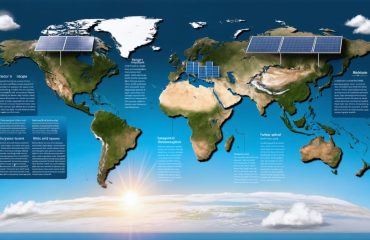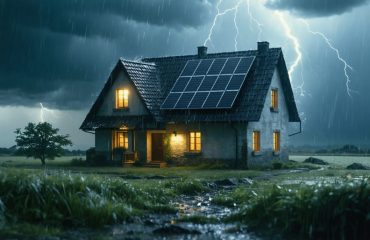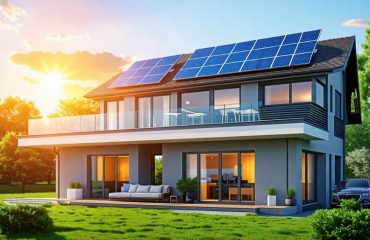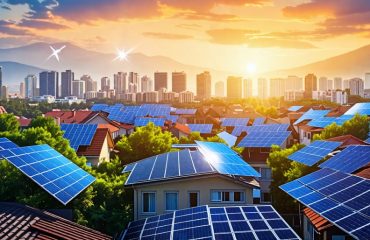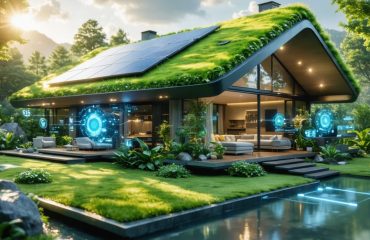Imagine powering your home with sunlight that’s completely invisible to the naked eye. Transparent solar panels, once confined to science fiction, are revolutionizing how we think about renewable energy in residential spaces. These innovative panels transform ordinary windows and glass surfaces into power-generating assets while maintaining their crystal-clear appearance, offering homeowners a seamless blend of sustainability and style.
Recent breakthroughs in transparent solar technology have achieved power conversion efficiencies of up to 10%, while remaining virtually indistinguishable from regular glass. This game-changing development means homeowners can now harness solar energy without compromising their property’s aesthetic appeal or architectural integrity. From smart windows that automatically adjust their tint to maximize energy capture, to invisible solar films that can be retrofitted onto existing glass surfaces, these technologies are making sustainable living more accessible and attractive than ever before.
As climate concerns grow and energy costs rise, invisible solar panels represent more than just technological innovation – they offer a practical solution for homeowners seeking to reduce their carbon footprint without sacrificing visual appeal.
What Makes Solar Panels ‘Invisible’?
The Science Behind Transparency
The secret behind invisible solar panels lies in their innovative design using transparent photovoltaic technology. Unlike traditional solar panels that absorb visible light, these advanced panels primarily capture ultraviolet and infrared light – parts of the light spectrum our eyes can’t see. Think of them as specialized windows with microscopic solar cells that let visible light pass through while harvesting energy from invisible light waves.
The panels achieve transparency through a clever combination of selective light absorption and luminescent solar concentrators. These concentrators are essentially transparent sheets containing special molecules that capture non-visible light and guide it to tiny solar cells hidden in the panel’s frame. This process allows the panels to generate electricity while maintaining up to 90% transparency.
The technology uses organic salts that naturally absorb ultraviolet light, converting it into infrared light that is then transformed into electricity. This means you can enjoy clear views through your windows while they quietly generate power for your home. While these panels may produce less electricity than traditional solar panels, their ability to be integrated into existing windows and glass surfaces makes them an attractive option for modern, energy-efficient homes.
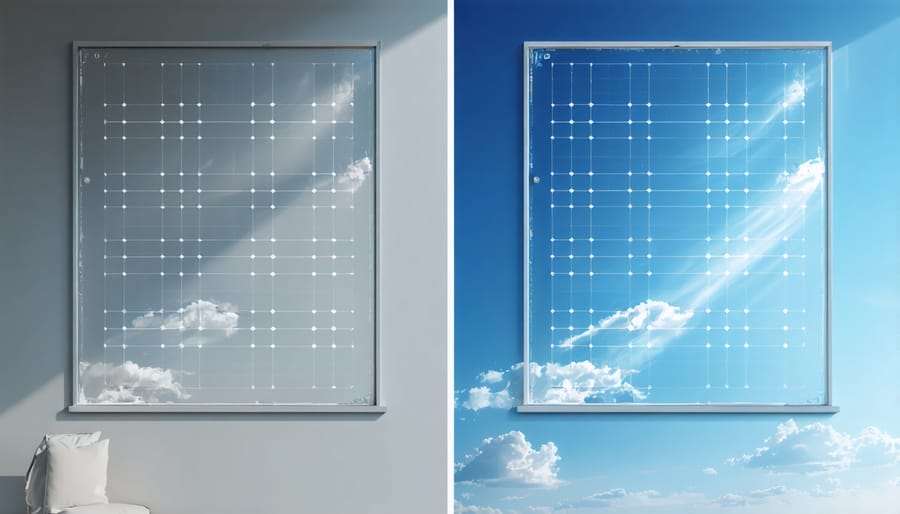
Integration with Existing Structures
Invisible solar panels seamlessly integrate into existing home structures, offering homeowners a sophisticated approach to renewable energy. These innovative panels can replace traditional window glass, transforming ordinary windows into energy-generating surfaces while maintaining transparency. When incorporated into high-performance solar home systems, invisible panels can be installed in skylights, glass doors, and even conservatory roofs.
The installation process typically involves replacing existing glass elements with solar-integrated panels, requiring minimal structural modifications. These panels work particularly well in large windows, glass facades, and sunrooms, where they can capture maximum sunlight while preserving the architectural aesthetics. For homeowners with historic properties or strict homeowner association guidelines, invisible panels offer a discrete solution for solar adoption.
Modern invisible panels can also be retrofitted into existing window frames, making them an accessible option for most homes. They’re particularly effective when strategically placed in south-facing windows or areas that receive abundant natural light, maximizing both energy generation and natural illumination throughout your living spaces.
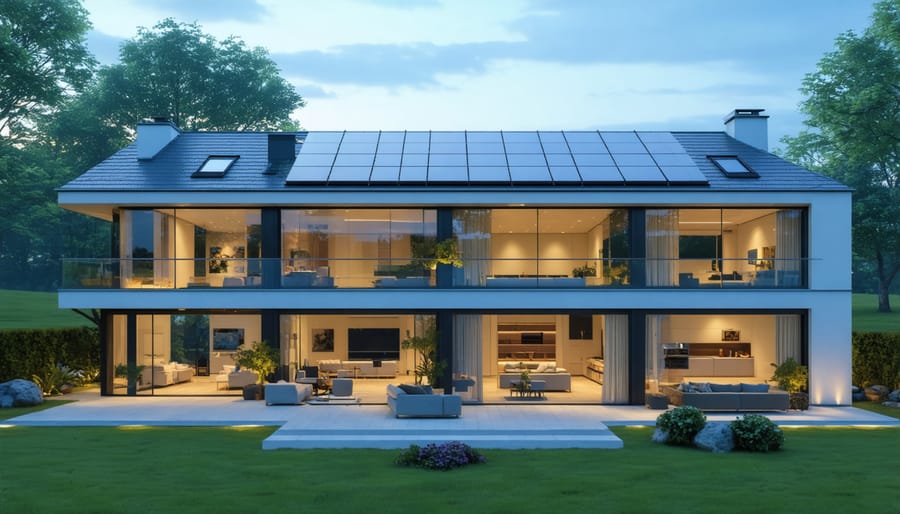
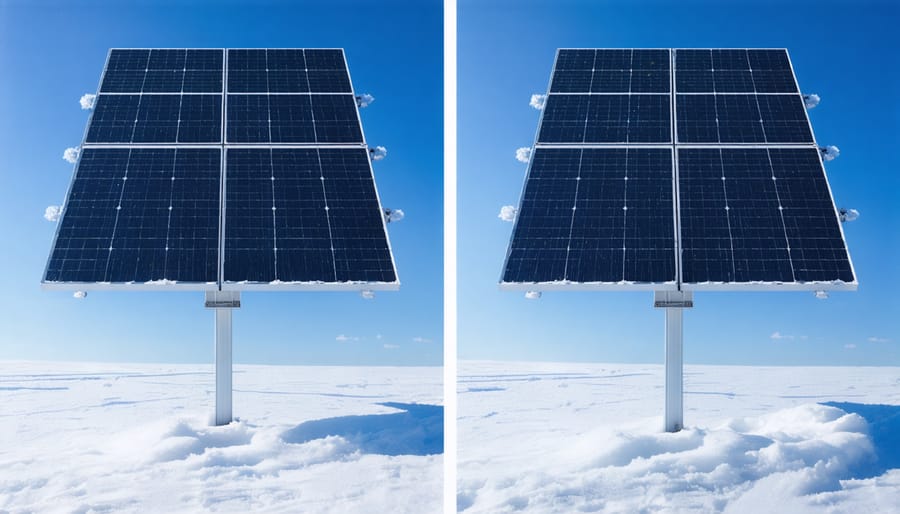
Climate-Specific Advantages
Cold Climate Performance
Invisible solar panels offer surprising advantages in cold, snowy climates, making them an excellent choice for homeowners in northern regions. Unlike traditional panels, their smooth, seamless surface prevents snow from easily accumulating, helping maintain energy production during winter months. The integrated design also means less risk of snow and ice damage to the installation.
The panels’ advanced technology actually performs more efficiently in cold temperatures, as lower temperatures increase the conductivity of electrical materials. This means you can generate more electricity from the same amount of sunlight compared to warmer days. During winter, the reflective properties of snow can actually boost energy production by bouncing additional sunlight onto the panels.
For homes in snowy areas, these panels are typically installed at an optimal angle that promotes natural snow shedding. The dark surface of invisible solar panels, though not immediately apparent to the eye, absorbs enough heat to help melt snow faster than traditional roofing materials. This self-clearing feature reduces the need for manual snow removal and maintenance.
Additionally, the robust construction of invisible solar panels includes reinforced materials designed to handle heavy snow loads common in northern climates. This durability, combined with their seamless integration into your roof, provides excellent protection against harsh winter conditions while maintaining your home’s aesthetic appeal.
Hot Climate Applications
Invisible solar panels excel in hot, sunny regions, offering unique advantages that make them particularly well-suited for warm climates. Their transparent design actually helps manage heat more effectively than traditional panels, as they can be integrated into windows and facades while maintaining natural ventilation. This innovative approach to solar performance in hot climates allows buildings to stay cooler while generating clean energy.
The panels’ heat-resistant properties enable them to maintain efficiency even during intense summer months. By incorporating these panels into existing glass surfaces, homeowners can create a dual-purpose solution that both generates power and reduces indoor temperatures through selective light filtering. This results in lower air conditioning costs and improved overall energy efficiency.
Additionally, invisible solar technology includes advanced heat management features that prevent overheating and maintain optimal performance levels. The panels’ design allows for better air circulation compared to traditional roof-mounted systems, which can trap heat between the panels and roof surface. This improved ventilation helps extend the lifespan of the system while ensuring consistent energy production throughout the year.
For homeowners in sunny regions, these panels offer the perfect balance of aesthetics and functionality, turning hot, sunny days into maximum energy-generating opportunities without compromising your home’s appearance or comfort.
Real-World Applications
Residential Success Stories
Sarah and Tom Bennett from Colorado transformed their historic Victorian home with transparent solar windows, maintaining its 19th-century charm while cutting energy costs by 65%. “Our neighbors didn’t even notice the installation until we showed them our utility bills,” Sarah shares.
In Seattle, the Martinez family installed invisible solar cells integrated into their roof tiles during a renovation. Despite the city’s frequent cloud cover, they generate enough power to meet 80% of their home’s energy needs while preserving their property’s modern aesthetic.
Retired couple Janet and Michael Lee from Florida embraced solar glass technology in their sunroom addition. The smart glass not only generates power but also automatically tints to reduce heat gain, leading to a 40% decrease in cooling costs during summer months.
These success stories demonstrate how invisible solar solutions can blend seamlessly with various architectural styles while delivering significant energy savings. Each installation required minimal structural modifications and maintained the original character of the homes, proving that sustainable technology can coexist with aesthetic preferences.
Future Possibilities
The future of invisible solar panels is incredibly promising, with researchers developing even more innovative solutions. Transparent solar cells are expected to achieve higher efficiency rates, potentially reaching 12-15% in the next few years, making them increasingly competitive with traditional panels. Building-integrated photovoltaics could soon become standard in new construction, with windows, skylights, and entire glass facades serving as power generators.
Smart homes of the future might feature self-tinting invisible solar windows that automatically adjust their transparency based on sunlight intensity, maximizing both energy generation and indoor comfort. Car manufacturers are already exploring the integration of invisible solar technology into sunroofs and windows, potentially extending electric vehicle ranges.
Another exciting development is the possibility of combining invisible solar technology with urban farming, creating greenhouse spaces that generate power while growing food. Scientists are also working on flexible transparent solar films that could be applied to existing windows as easy-to-install overlays, making solar adoption more accessible to homeowners.
These advancements point toward a future where solar power generation seamlessly integrates into our daily lives, without compromising on aesthetics or functionality.
Making the Switch
Making the switch to invisible solar panels requires careful consideration of several key factors. First, assess your home’s architectural style and roof condition – these panels work best on newer roofs with simple layouts. You’ll also need to evaluate your local climate and sun exposure patterns to ensure optimal energy generation.
The installation process typically begins with a professional assessment of your property. An experienced solar consultant will evaluate your energy needs, roof structure, and local building codes. They’ll also help you understand the energy savings and environmental benefits specific to your situation.
Cost considerations are crucial. While invisible solar panels generally carry a higher upfront cost than traditional panels, many homeowners find the aesthetic value and potential increase in property value worth the investment. Various financing options, including solar loans and lease programs, can help make the transition more affordable.
Planning ahead is essential. Start by obtaining multiple quotes from certified installers who specialize in invisible solar technology. Check their credentials and ask for references from previous installations. It’s also wise to review your homeowner’s insurance policy and ensure it covers these specialized panels.
Remember to investigate local regulations and HOA restrictions before proceeding. Many communities have specific guidelines for solar installations, though most states have “solar rights” laws that prevent HOAs from completely restricting solar panel installation. Finally, consider the warranty terms and maintenance requirements to ensure you’re prepared for long-term ownership.
Invisible solar panels represent a revolutionary step forward in sustainable living, offering homeowners the perfect balance between energy efficiency and aesthetic appeal. By seamlessly integrating into your home’s existing architecture, these innovative solutions make it easier than ever to embrace clean energy without compromising your property’s appearance. Not only do they help reduce your carbon footprint and energy bills, but they also protect against rising electricity costs while potentially increasing your home’s value. As solar technology continues to advance, invisible solar panels are becoming increasingly accessible and affordable. Whether you’re renovating your home or building from scratch, consider making the switch to invisible solar panels – a smart investment that benefits both your wallet and the planet. The future of sustainable housing is here, and it’s beautifully invisible.

